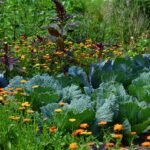You Won’t Believe How Much Food Fits in a Tiny Backyard!
How to Plan Your Backyard for a Self-Sufficient Garden
Learn how to design your backyard layout for maximum food production, even in small spaces.
Why Planning Matters
Before planting a single seed, take time to understand the conditions of your yard. Start by watching how the sun moves across your space throughout the day. Most vegetables thrive on 6–8 hours of direct sunlight, so take note of the sunniest spots. Shadier areas aren’t wasted though — they’re perfect for leafy greens, herbs, or cool-season crops.
How to Plan Your Backyard
1. Assess Your Space
-
Next, pay attention to how water behaves in your yard. After a rain, observe where water tends to pool and where it drains quickly. Low-lying areas can drown plants, while dry patches may need extra irrigation. Knowing this helps you plan where to place raised beds, pathways, or rain barrels for maximum efficiency.
-
Finally, measure your space. Even small yards, patios, or balconies can be transformed into productive gardens when you know exactly how much room you have. Sketch out the dimensions so you can visualize beds, containers, or vertical structures.
-
By assessing your sunlight, water, and space upfront, you set yourself up for fewer mistakes, healthier plants, and a much more abundant harvest.
2. Sketch a Layout
- Draw a simple map of your yard. Plan where your raised beds, compost bins, and walkways will go.
- Leave room for expansions like chickens, fruit trees, a greenhouse, containers, or additional beds.
- Note the path of the sun, and where your water naturally pools.
3 Think Vertical
- Don’t limit yourself to just the ground — use the space above it! Vertical gardening allows you to grow more food in less square footage while keeping your plants healthier and easier to manage.
- Use trellises or wire supports for vining crops like beans, cucumbers, and peas. Add cages or sturdy stakes for tomatoes to keep fruit off the soil and prevent rot. For herbs or strawberries, consider hanging planters, wall-mounted pockets, or stacked shelves that bring food production upward.
- Not only does vertical gardening save valuable space, it also improves airflow, reduces pest problems, and makes harvesting easier. By training plants upward, you can maximize every inch of your backyard — even on patios, balconies, or small city lots.
4. Start Small
-
One of the biggest mistakes new gardeners make is trying to do too much at once. Instead of building a huge garden right away, begin with just one or two raised beds or a handful of large containers. This lets you learn the basics of soil, watering, and pests without feeling overwhelmed.
-
Choose easy, reliable crops like lettuce, beans, or tomatoes. Lettuce grows quickly and keeps producing, beans are low-maintenance and rewarding, and tomatoes thrive with just a bit of support. By focusing on a few crops, you’ll gain confidence, enjoy early success, and reduce frustration.
-
Once you’ve mastered those, you can expand your garden gradually — adding more beds, trying new crops, and experimenting with techniques like succession planting or vertical growing. Starting small keeps gardening fun, manageable, and sustainable, ensuring you’ll stick with it for years to come.
4. Think Vertical
- Don’t limit yourself to just the ground — use the space above it! Vertical gardening allows you to grow more food in less square footage while keeping your plants healthier and easier to manage.
- Use trellises or wire supports for vining crops like beans, cucumbers, and peas. Add cages or sturdy stakes for tomatoes to keep fruit off the soil and prevent rot. For herbs or strawberries, consider hanging planters, wall-mounted pockets, or stacked shelves that bring food production upward.
- Not only does vertical gardening save valuable space, it also improves airflow, reduces pest problems, and makes harvesting easier. By training plants upward, you can maximize every inch of your backyard — even on patios, balconies, or small city lots.
Smart planning today saves you time, energy, and frustration down the road. 🌱 If you want a complete step-by-step blueprint for transforming your backyard into a true food powerhouse, check out The Self-Sufficient Backyard.
👉 And don’t miss our free planting guide, customized by your ZIP code, so you’ll always know the best time to grow in your area.
This article contains affiliate links. If you make a purchase, I may earn a small commission at no extra cost to you.
Shopping List
- Graph paper or garden planner app
- Raised bed kit or lumber
- Basic hand tools (spade, hoe, rake)
- Trellis or vertical garden supports
👉 Click here to get 7 Steps to a Self-Sufficient Backyard
👉 Click here to get your Local Survival Gardening Calculator
- The One Skill That Could Save Your Family in a Crisis!
- Turn 1 Week of Harvest Into 6 Months of Food!
- Backyard Chickens: The Secret to Never Buying Eggs Again!
- Save Thousands with This Simple Backyard Water Hack!
- 7 Crops That Practically Grow Themselves (and Feed You Nonstop!)
- This Dirt Trick Could Feed Your Family Forever!
- You Won’t Believe How Much Food Fits in a Tiny Backyard!
- Cultivating Your Greens: A Beginner’s Guide to Starting a Vegetable Garden
- The Green Pharmacy: Cultivating Wellness in Your Backyard
